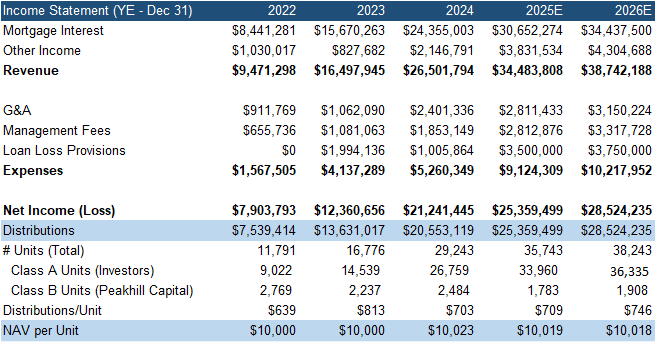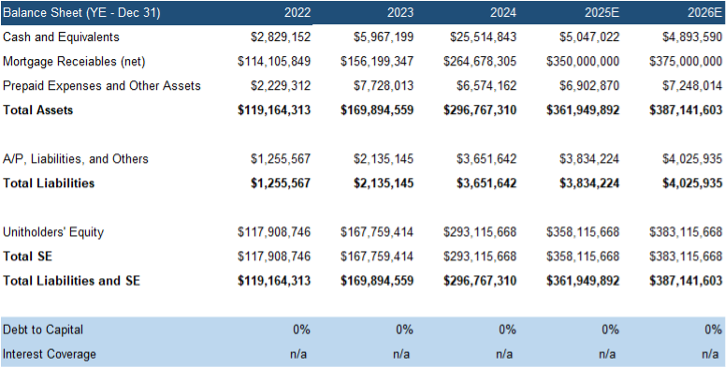Peakhill Income Opportunity LP
Bridging the Gap for CMHC-Insured Mortgages – Initiating Coverage
Published: 10/23/2025
Author: FRC Analysts

Sector: N/A | Industry: Mortgage Investment
| Metrics | Value |
|---|---|
| Current Price | N/A |
| Fair Value | N/A |
| Risk | 2 |
| 52 Week Range | N/A |
| Shares O/S (M) | N/A |
| Market Cap. (M) | N/A |
| Current Yield (%) | N/A |
| P/E (forward) | N/A |
| P/B | N/A |
Already a subscriber?
Want to know the fair value of the stock?
Subscribe for free to get exclusive insights and data.
Report Highlights
- Peakhill Income Opportunity LP (“fund” or “LP”), established in 2020, is a mortgage investment vehicle primarily focused on short-term bridge financing for income-producing multi-family properties seeking CMHC insurance. We view CMHC-insured loans as relatively low risk, given the government guarantee in the event of borrower default.
- The fund’s manager, Peakhill Capital, has been in the mortgage business since 2020. Since inception, the manager has funded $14.8B across 1,900+ loans, including $9B in CMHC-insured loans. The manager, and the management team, have significant skin in the game, having invested $22M in the fund, representing 6% of units. Additionally, the manager guarantees the first $15M of investor losses.
- At the end of Q2 2025, the fund held $333M in mortgages, with CMHC bridge loans representing 72% of the portfolio. Ontario accounted for 53% of exposure, followed by Alberta (21%), and Quebec (18%).
- In H1-2025, the yield was 9.1% vs 10.1% in 2024 (full year), driven by lower interest rates. Note that 95% of mortgages are floating rate.
- Multi-family rents in major Canadian cities have declined over the past year, as vacancies rose due to higher supply, weaker employment, and fewer international students. We remain positive on the Canadian multi-family rental market, supported by steady long-term demand, high property prices, and affordability challenges from elevated mortgage rates.
- Since late 2024, the Bank of Canada has cut rates twice (50 bps total). We see room for one or two more cuts in the next six months, amid slowing GDP growth, elevated trade tensions, high unemployment, and cooling inflation. While mortgage delinquencies remain a concern, lower rates should ease pressure by reducing financing costs, compressing cap rates, and supporting property valuations, benefiting Peakhill’s borrowers.
- We find high-yielding funds, like Peakhill, increasingly attractive in the current declining rate environment. This is because MIE lending rates are less elastic, meaning their yields tend to decline less in a falling rate environment, and rise more slowly in a rising rate environment. We are forecasting a yield of 8.9% in 2025 vs 10.1% in 2024.
Risks
- Highly competitive sector
- A downturn in the real estate sector may impact the company’s deal flow
- No guaranteed distributions
- Default rates can rise during recession
- Timely deployment of capital is critical

* Peakhill has paid FRC a fee for research coverage and distribution of reports. See last page for other important disclosures, rating, and risk definitions. All figures in C$ unless otherwise specified.
An Overview of Mortgage Investment Entities (MIEs)
MIEs provide short-term loans, typically one to two years, secured by Canadian real estate. With more flexible lending guidelines than traditional lenders, MIEs can offer tailor-made solutions to meet specific borrower needs. Unlike banks, which have lengthy due diligence processes, MIEs can respond quickly to urgent capital requirements. As a result, they are able to charge higher interest rates than banks and other conventional lenders.
Key features:
- External Management Structure: Most MIEs are externally managed by their founders through a separate management company, which earns management and/or performance fees, as well as a share of the origination fees paid by borrowers.
- Revenue Generation: MIEs generate revenue primarily through interest income earned on loans extended to borrowers.
- Capital Structure: Mortgages are financed through a combination of debt (typically from banks or traditional lenders) and equity (raised from investors).
- Tax Efficiency: To maintain tax efficiency and avoid entity-level taxation, MIEs generally distribute 100% of their taxable income to investors.
In a recent market study conducted for the Canada Mortgage and Housing Corporation (“CMHC”), we estimated that there are approximately 200 MIEs in the country managing approximately $20B, accounting for 0.9% of the total residential mortgage credit in Canada ($2.3T).
Company Overview and Manager Background
Founded in 2020, the fund is managed by Peakhill Capital Inc. (founded in 2019), owned by Harley Gold and employees. Brief biographies of the management team follow.
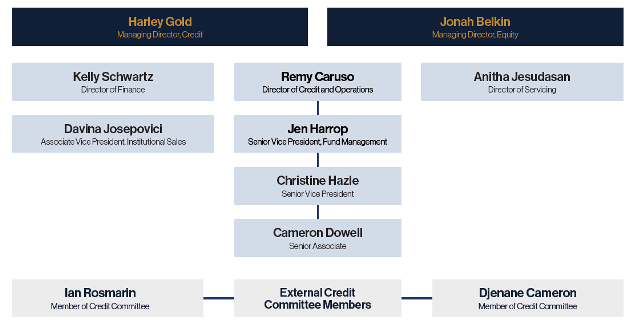
Source: Peakhill Capital
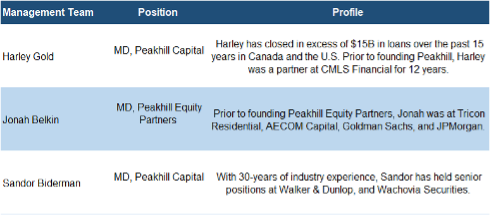
Source: Peakhill Capital
With over $12B in assets under administration, Peakhill Capital is a commercial (multi-family) real estate lender providing financing to developers and investors, having serviced over 500 clients since its inception. The manager originated $5.5B in loans in 2024 vs $3.5B in 2023.
Peakhill provides term, bridge, construction, and equity financing, mainly for multi-family projects, as well as for industrial, office, retail, and hospitality assets across Canada and the U.S. Additionally, the firm offers CMHC-insured and bridge loans in Canada, and is one of the largest CMHC-insured private lenders in the apartment sector.
Key Business Initiatives


Source: Peakhill Capital
Management fees range from 0.60% to 1.50% p.a. of mortgages outstanding, depending on the investment amount. The manager does not charge a performance fee, and has historically shared 50% of commitment fees. We estimate total annual management fees and operating expenses, net of shared commitment fees, at under 1.5% of mortgage receivables, broadly in line with comparable funds.
Investment Strategy
- Primarily focused on first mortgages on commercial properties in Canada
- Loan sizes typically range from $1 to $10M; the LP’s participation share generally ranges from 20% to 100% of each loan
- Mortgage terms are typically six to 24 months, with an average duration of eight months as of June 30, 2025
- The portfolio’s weighted average loan-to-value (LTV) will not exceed 75%
- Income-producing assets typically make up at least 85% of the portfolio, which we believe keeps the fund relatively lower risk compared to funds focused on development and construction projects
- Loans are floating rate, allowing the fund to quickly adjust to market rates
- All of the fund’s loans are demand loans, allowing the manager to call loans or require paydowns if property value or borrower performance deteriorates, ensuring borrowers remain accountable
Sample Deals
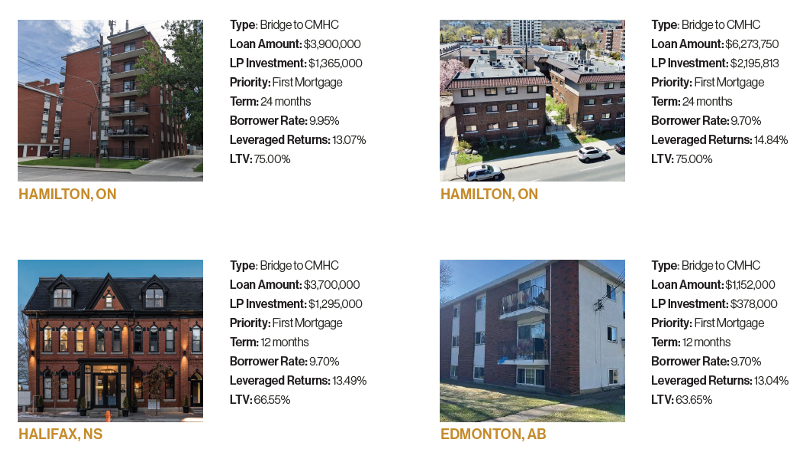
Source: Peakhill Capital
The LP primarily provides bridge loans to income-producing multi-family properties seeking CMHC insurance. Once coverage is secured, Peakhill facilitates a takeout loan with one of its institutional partners, allowing the property to transition to long-term financing at more favorable rates. We believe this well-defined exit strategy makes the loans particularly appealing to Peakhill, as it ensures a clear repayment path and reduces default risk.
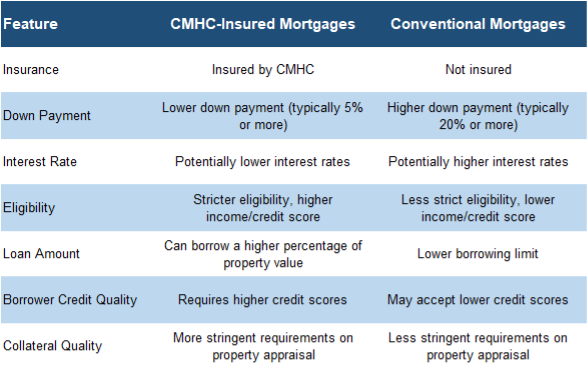
Source: FRC
The following table shows how Peakhill LP’s portfolio compares to that of other similar MIEs (with AUM of $100M+).
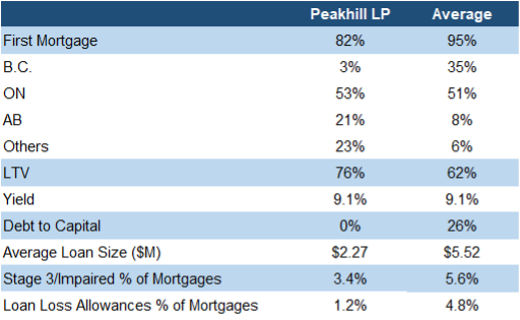
Source: FRC / Various
Portfolio Details (YE: December 31st)
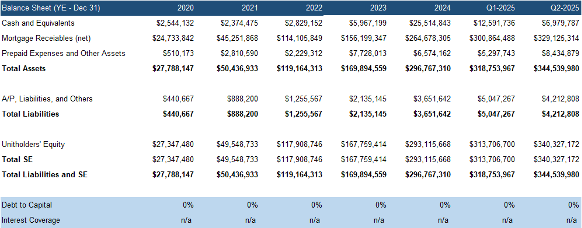
Source: FRC / Data from Peakhill Capital
At the end of Q2-2025, the fund had $340M in equity, with $323M from investors (Class A), and $17M from the manager (Class B). The fund distributes 8% p.a. to Class A monthly, followed by 8% to Class B, with all excess profits distributed pro rata at year-end. Class A Units have priority on distributions, redemption rights, and return of capital in the event of liquidation, with Class B Units absorbing the first $15M of losses (in the event of liquidation), after which, both units participate equally and pro rata.
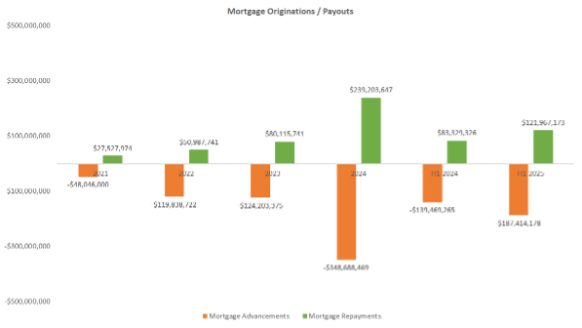
Source: FRC / Data from Peakhill Capital
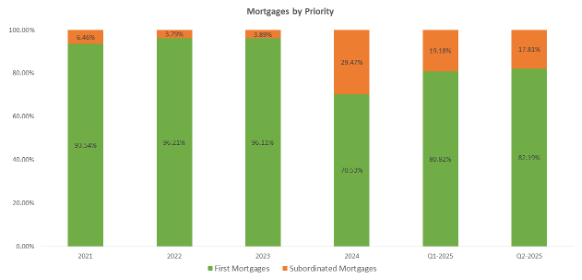
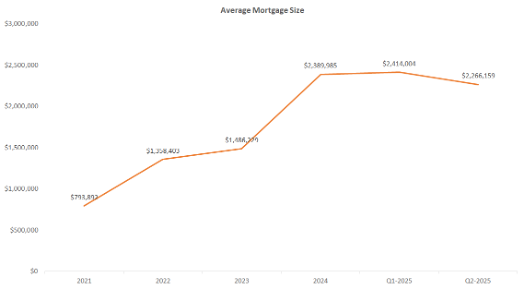
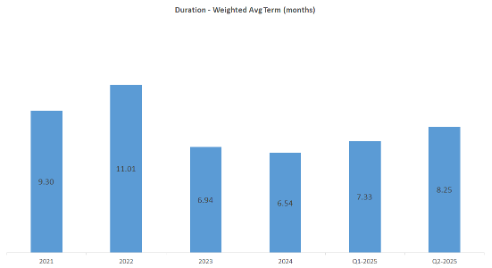
Source: FRC / Data from Peakhill Capital
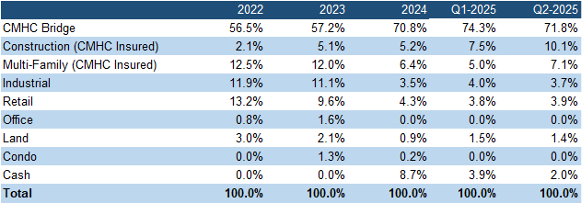
Geographical Diversification
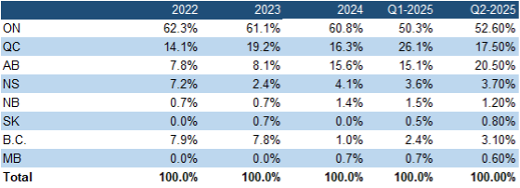
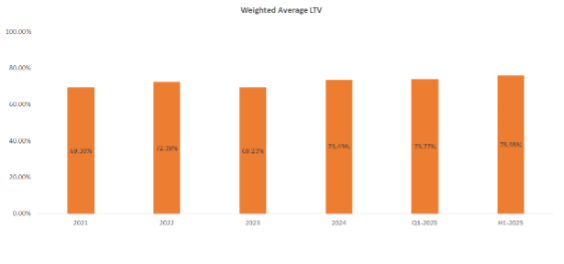
Source: FRC / Data from Peakhill Capital
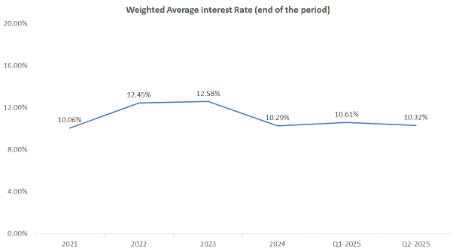

Source: FRC / Data from Peakhill Capital
Financials
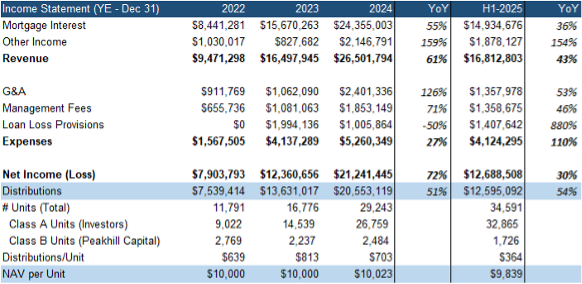
Source: FRC / Data from Peakhill Capital
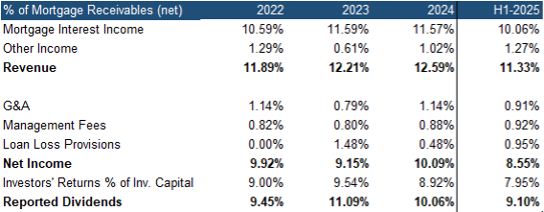
Note that the above figures may be slightly different from the figures reported by the MIE due to differences in the method of calculation. We used the average of the opening and year-end balances of mortgages outstanding and invested capital.
Source: FRC / Data from Peakhill Capital
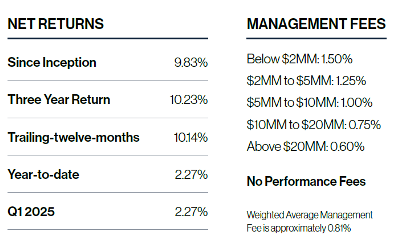

Source: Peakhill Capital
FRC Projections and Rating

Source: FRC

Source: FRC
We are initiating coverage with an overall rating of 2-, and risk rating of 2. We find high-yielding funds, like Peakhill, increasingly attractive in the current declining rate environment. This is because MIE lending rates are less elastic, meaning their yields tend to decline less in a falling rate environment, and rise more slowly in a rising rate environment. Given the BoC’s recent and anticipated rate cuts, yields are set to decline. However, we believe the risk of higher default rates is easing, and the mortgage origination market is likely to gain momentum in 2026.
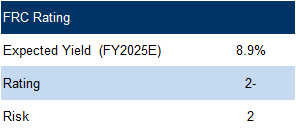
Risks
We believe the fund is exposed to the following key risks (not exhaustive):
- Highly competitive sector
- A downturn in the real estate sector may impact the company’s deal flow
- No guaranteed distributions
- Default rates can rise during recession
- Timely deployment of capital is critical
APPENDIX
